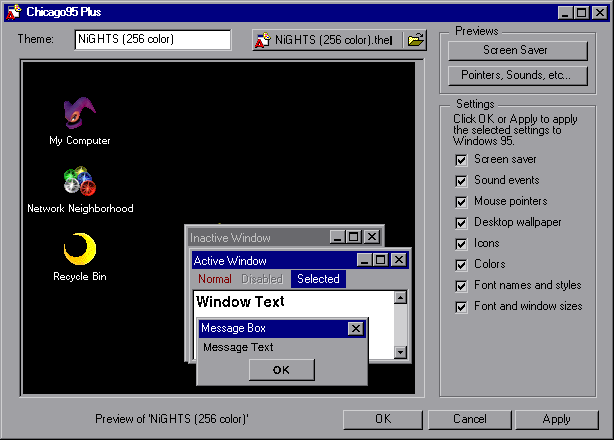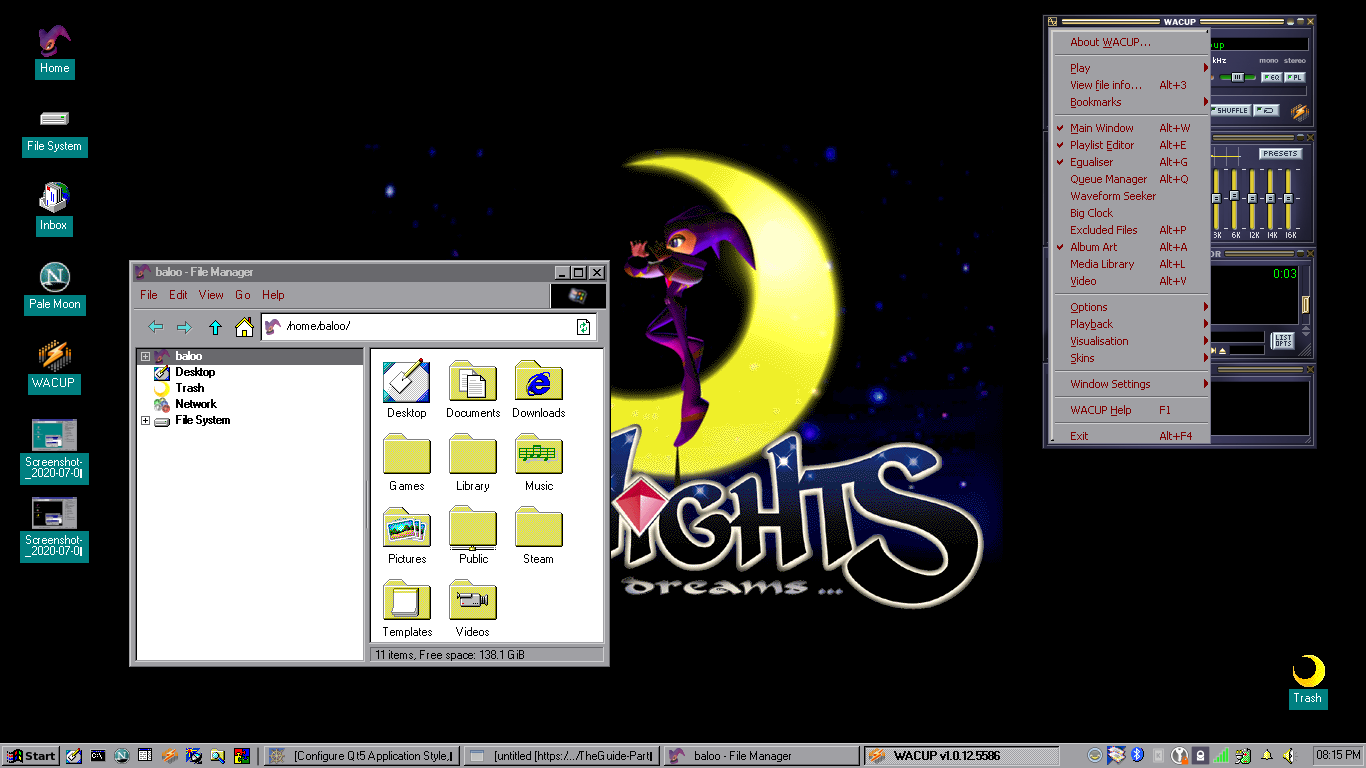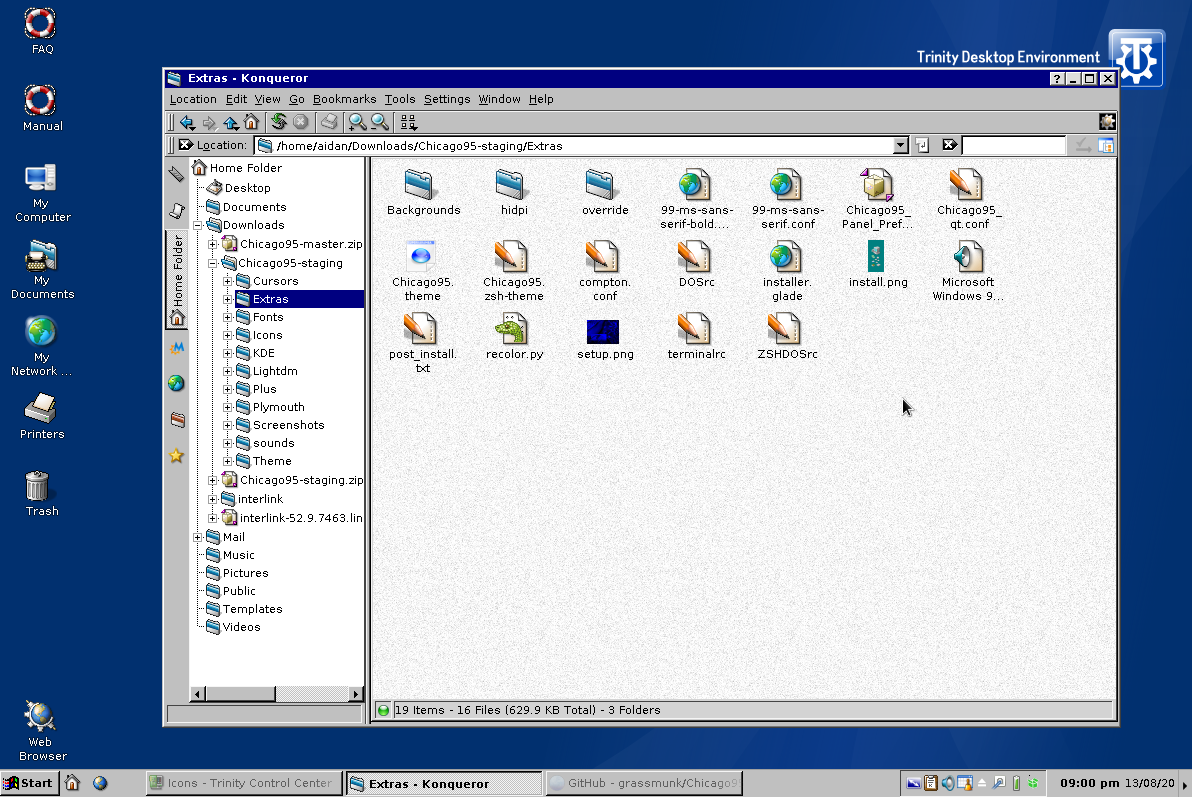Change your Desktop GUI to look like Windows 95/98
The gold
standard of Desktop GUIs in the 1990s was Windows 95/98. It wasn't the
only one, but the vaporwave motif comes from this GUI. With not too
much difference between 95 and 98 aside from a few icons, we will
refer to them both here as the same. Here's a video of what Windows 95
actually looks like so we can make it look just like the real thing.
I'll go through the instructions on how to in both Windows and Linux.
Windows Instructions:
EDIT: I no longer recommend using Windows 7, or really any Windows OS
at all with current changes. Windows 7 is now totally unsupported and
out-of-date, and Windows 11 requires a Microsoft account, which
effectively makes it spyware software as a service. No thanks.
If you are still running Windows 7, you're in luck. Windows 7 has Classic theme baked right in, and you can activate it by simply right-clicking and going to Personalize. Scroll down to Windows Classic theme, select, and voila you've got the Classic Style Windows Theme. But things get a bit more difficult if you're running later versions of Windows.
You will also want to check out the OpenShell program. This allows you theme your Start Menu to look just like Windows 95/98. A user named R.O.B. has also created skins for OpenShell that allow you to theme it to precisely whichever version of Windows you want it to look like. The Winaero Tweaker allows you to reinstate in Windows things like the original Startup DLL, the original Volume adjuster, and a few other tweaks.
If you're on Windows 10, and you've updated anytime recently, unfortunately Classic Theme is more or less not available for you, as the explorer no longer works in versions newer than Windows 10 Build 1803. If you want classic theme and insist on using Windows, considering downgrading to Windows 8.1 or Windows 7, or using Windows 10 LTSC/LTSB. If you want to try to activate Classic Theme in Windows 10, then check out the Winclassic Boards. There are a few scripts that can be run to activate Classic theme, but be warned, things will break. Icons are very difficult to change, but can be done so using a program called CustomizerGod. The Taskbar can additionally be manipulated through a couple of different older programs. For what Classic Theme can look like on Windows 10, take a look at this thread from user Clasurol.
Linux Instructions
After the constant fighting with Windows to change icons, and activate classic theme, I headed for greener pastures with Linux. If you're strong enough to get off of Windows, your best option to get a working classic theme is ironically, to use a Linux desktop. I use Debian Testing, but if you are a beginner I would recommend Xubuntu. Then, go and check out these two great Desktop Environments:
Chicago95 for XFCE Desktops
The best option at the moment is the great Chicago95
Theme developed
by Grassmunk and EMH-Mark-I developed here on Github.
Here is the way my current desktop looks in Debian for reference.

Pretty convincing, isn't it? With the new GUI installer for Chicago95 released, you can simply run the "install.py" script found in the theme folder and for the most part be on your merry way. However, there are a few things you may need to do.
- To run the Plymouth theme found in Chicago95 in Debian, you will likely first have to edit the system files depending on your video card. Check out these instructions for Debian here on how to activate Plymouth. You may need to change some settings. This may also be the case for other Linux distros that do not initially have Plymouth installed and configured.
- There is an error with the Microsoft Sans Serif font where it does not properly bold by itself. Follow the instructions, and use MS Sans Serif instead of Microsoft Sans Serif. However, when using MS Sans Serif, note that there is not a character for ellipses "..." so you will see a block character instead.
- When using Canberra for the system sounds, you can simply run a
Canberra command in Session & Startup to make sure your Startup
sound stays consistent if you choose to change the sound theme with a
Microsoft Plus Theme (Yes, Chicago95 has support for those as well!
Details below.) In session and startup, simply make a command in the
Session & Startup > Application Autostart tab with the
following command:
- canberra-gtk-play -i desktop-login
To play the system sound at startup. Choose "On Login" in the dropdown menu for activation.
- Adding wallpapers is not simple in XFCE on Linux. You will have to navigate to the usr/share/backgrounds folder and, as root user, add any background wallpapers that you wish to use. Then, you will be able to change your wallpaper. It is not as obvious as Windows in this regard.
Microsoft Plus Themes in Chicago95
But what about the old Plus themes for Windows? Well, thanks to the hard work of these developers, you can use those as well. Chicago95 also has a GUI Installer, and instructions on how to use Chicago95 Plus! can be found here. I will note however that Chicago 95 Plus's Python script isn't as straightforward, but it is almost there with regards to setting up a theme, so I will show you how to set it up here.
Instructions:
First, we will start by finding a suitable Plus! theme to use, a lot of which are hosted on the Web Archive. I find a lot of the ones archived on Archive.org a bit ugly and not well-designed personally, but the best place to find one suitable for testing is generally there. Here are what I think a few good plus themes.
Harvey Birdman, Attorney At Law
- Start by downloading your theme of choice, such as one of the ones above. For this demo, we will use the NiGHTS into Dreams... theme. Then, download the full Zip of Chicago95 from the Github instance, and navigate to the Plus folder and the PlusGUI.py file. Open the Terminal, and run this file. You can do that by either running the full path to the file in the terminal, or right-clicking the file and selecting "Open with: Terminal Emulator"
- You will be greeted with this prompt:

- Go ahead and navigate to your theme. Since we are using the NiGHTS
into Dreams one, it should look like this.

- Simply hit Apply, and let the script run. Some parts of the script may automatically apply, some may not. The script is configured to place the individual folders of Sounds, Theme changes, Icons, and Cursors into the proper folders. I am unsure about the Screensaver placement, but if your theme comes with a .SCR file, that is addressed later in this guide.
- You're going to want to open up "Settings Manager" in your Tasker
Menu for XFCE4, and navigate to the following Menus and select your
generated theme:
- Appearance > Icons Tab
- Appearance > Themes Tab
- Window Manager > Style
- Mouse & Touchpad > Theme Tab
- To change the sound to the new sound setting, simply put in this
command:
- xfconf-query -c xsettings -p /Net/SoundThemeName -s
"Theme Folder Name Here"
- xfconf-query -c xsettings -p /Net/SoundThemeName -s
"Theme Folder Name Here"
- To change the background, right-click and hit Desktop Settings, then navigate to the proper folder where the wallpaper is located.
- If a part of the theme did not generate into the directory it needs
to go to be read by XFCE to change, you'll want to navigate back to
your Chicago95/Plus folder. In that folder will be a folder named for
the Plus theme you wish to apply. In this case, the folder is entitled
NiGHTS_(256 Color)_Theme for the theme we are using for this demo. In
that folder will be six individual folders for each style. Move the
folders to the following locations, first by hitting Ctrl+H to
ensure that the hidden folders appear:
- Themes: home/.themes
- Icons & Cursor: home/.icons
- Sounds: /home/.local/share/Sounds
- Wallpaper: /usr/share/backgrounds
- After you have finished changing the settings, finally to make WINE programs match your current setting, type in "winecfg" into the terminal, and navigate to the Desktop Integration tab. Once again, select your MS Plus Theme, and WINE will adapt to that plus theme in conformance to the rest of your desktop GUI.
- To make Qt5 programs also conform to Chicago95, be sure to install
the Qt5 Settings package "qt5ct" using
- sudo apt-get install qt5ct
- Now my background looks like this!

Trinity Desktop Environment
This fork of KDE 3.5 has maintained its similarity to Windows, and with a few tweaks it too can look just like Windows, though it is extremely similar looking to Windows in its own right. Despite being open-source, not many distros hold the Trinity Desktop Environment in their repository. It comes with a rather large number of programs in the desktop environment, including a program called Konqueror which is both a full-fledge web browser and File Manager, as well as calendar, address book, RSS feed, ebook reader, FTP download software, and a variety of games and other random programs. Some work better than others, and sometimes the programs feel a little too tighly woven together if you're not used to using an entire suite of apps for one purpose. The biggest flaw of TDE is the Konqueror file manager, which is woefully out of date in a lot of respects: It has major trouble with file associations, can't mount encrypted hard drives, and the web browser is unusable in 2022.
If you want to give TDE a try, you can go to their website where ISOs
are offered for Ubuntu and Debian with it automatically installed. The
Trinity Desktop Environment website has a list of distros that by
default come with the Trinity Desktop Environment if you wish to choose
one of them, such as Q4OS or Exe GNU/Linux.
Or you can simply opt to install the desktop environment itself via
TDE's own maintained repository that you can add to your source.list
file in Linux, but that is a little more complex. Currently there are
packages available for Ubuntu, Debian, Devuan, Red Hat, and
Fedora. You can get TDE from here:
https://www.trinitydesktop.org/
I personally recommend using Q4OS. It has some
issues, but it is based on Debian stable so I find it to be the most
compatible. Plus, it has some directly-designed
Combined with the Start Button and fonts from Chicago95, Here are some
tweaks you can use to make Trinity Desktop Environment look just like
Windows 95/98.
All icon packs created for XFCE in Chicago95 also work just fine with TDE. Edit: This was the case when I used TDE with Debian directly, but NOT when I attempted to use the XFCE-designed Icon packs with Q4OS. I am not sure if something has changed in TDE, or if Q4OS itself has regressions.
But Here are a few other tweaks to make TDE look very similar to Windows:
Theme:- Select the Redmond theme upon first install with the Wizard, or go to Trinity Control Center > Theme Manager .> Redmond and select the theme.
- In the Theme Manager Settings, click on "Colors" and select Redmond95 or RedmondXP, whichever you personally prefer.
- In Style, select the "Windows9x" widget style.
Change Taskbar Colors:
- Go to Trinity Control Center > Desktop > Taskbar
- Check the box for "Use Custom Colors"
- Set the text colours to #000000 and the background color to #C0C0C0
- Then go to Trinity Control Center > Appearance & Themes > Colors.
- On the right side in the "Widget Color" frame, you will have to select each item in a menu that ends in the name "Background"
- Set Text selection color to #000080. Set Background to #C0C0C0.
Set Inactive titlebar is #808080
There will be more to come on how to better tweak Trinity Desktop Environment. But there are two great options now in Linux for you to make your desktop look just like Windows. All of the pleasantries of the GUI that revolutionized computers, without any of the spyware.
Now, onto Part II! How to make your
browser look like Netscape Navigator.

